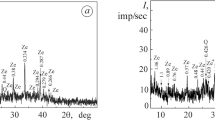Abstract
We studied the corrosion inhibition of galvanized steel in artificial acid rain solution by chromate-free pigments containing phosphate and calcium ions. We used the methods of electrochemical impedance spectroscopy, potentiodynamic polarization, electron microscopy, and X-ray microspectrum analysis. It was established that the combination of modified zinc phosphate and ion-exchange-type calcium-containing pigment provides a significant synergistic anticorrosion effect on galvanized steel as compared with the same inhibiting pigments used separately. The charge-transfer resistance of the metal in acid rain solution saturated with this pigment composition approaches that in the same solution with a chromate inhibitor and is significantly higher as compared with the solutions of separate pigments. Owing to the combination of nonchromate pigments, a protective film is formed on galvanized steel, which represents a complex mixture of calcium and zinc phosphates and guarantees the corrosion inhibition of galvanized steel under mixed cathodic-anodic control.
Similar content being viewed by others
REFERENCES
N. Wheat, “Protection since the lost arc. A review of primers and barrier coatings for steel,” Protective Coatings Europe, 3, No. 6, 24–30 (1998).
J. Barraclough and J. B. Harrison, “New leadless anti-corrosive pigments,” J. Oil Colour Chemists Assoc., 48, 341–355 (1965).
B. Elvers, S. Hawkins, and G. Schulz (editors), Ullmann's Encyclopedia of Industrial Chemistry, Fifth Ed., Vol. A20, Chap. 4.2: Anticorrosive Pigments (1992).
R. Romagnoli and V. F. Vetere, “Heterogeneous reaction between steel and zinc phosphate,” Corrosion, 51, No. 2, 116–123 (1995).
J. A. Burkill and J. E. O. Mayne, “The limitations of zinc phosphate as an inhibitive pigment,” J. Oil Colour Chemists Assoc., 71, No. 9, 273–275, 285 (1988).
J. E. O. Mayne, “New leadless anti-corrosive pigments. Discussion,” J. Oil Colour Chemists Assoc., 48, 352–356 (1965).
H. F. Clay and J. H. Cox, “Chromate and phosphate pigments in anti-corrosive primers,” J. Oil Colour Chemists Assoc., 56, 13–16 (1973).
S. C. J. Atwood, “Corrosion and coatings,” J. Oil Colour Chemists Assoc., 72, No. 4, 128–134 (1992).
M. Morcillo and M. P. Mateo, “Behaviour of anticorrosive paints formulated with nontoxic pigments,” Europ. Coatings J., No. 4, 270–282 (1988).
I. L. Rozenfel'd and F. I. Rubinshtein, Anticorrosion Primers and Inhibited Paint Coatings [in Russian], Khimiya, Moscow (1980).
I. L. Rozenfel'd, Corrosion Inhibitors [in Russian], Khimiya, Moscow (1977).
H. H. Uhlig, D. N. Triadis, and M. Stern, “Effect of oxygen, chlorides, and calcium ion on corrosion inhibition of iron by poly-phosphates,” J. Electrochem. Soc., 102, 59–65 (1955).
Z. Szklarska-Smialowska and J. Mankowski, “Le mecanisme de l'action des polyphosphates comme inhibiteurs de la corrosion de l'acier par l'eau,” Centre Belge D'etude et de Documentation des Eaux, 20, No. 288, 474–481 (1967).
B. A. Boukamp, Equivalent Circuit. Version 3.97, Faculty of Chemical Technology, University of Twente (1989).
Acid Rain. A Review of the Phenomenon in EEC and Europe. A Report Prepared for the Commission of the European Communities, Directorate-General for Environment, Consumer Protection and Nuclear Safety by Environmental Resources Lim., Graham and Trofman Lim., Brussels (1983).
U. Rammelt and G. Reinhard, “On the applicability of a constant phase element (CPE) to the estimation of roughness of solid metal electrodes,” Electrochimica Acta, 35, No. 6, 1045–1049 (1990)
G. N. Bhar, N. C. Debnath, and R. Sandir, “Effects of calcium ions on the morphology and corrosion resistance of zinc-phos-phated steel,” Surf. Coatings Technol., 35, 171–179 (1988).
G. B. Hatch, “Inhibition of cooling water,” in: C. C. Nathan (editor), Corrosion Inhibitors, NACE, Houston (1973), pp. 126–146.
B. P. F. Goldie, “Calcium exchanged silica anti-corrosion pigment: A review,” J. Oil Colour Chemists Assoc., 71, No. 9, 257–269 (1988).
Y. Tanizawa and T. Suzuki, “Effects of silicate ions on the formation and transformation of calcium phosphates in neutral aqueous solutions,” J. Chem. Soc. Faraday Trans., 91, No. 19, 3499–3503 (1995).
R. D. Armstrong and S. Zhou, “The corrosion inhibition of iron by silicate related materials,” Corros. Sci., 28, No. 12, 1171–1181 (1988).
G. H. Nancollas, “Phosphate precipitation in corrosion protection: Reaction mechanisms,” Corrosion, 39, No. 3, 77–82 (1983).
L. N. Shchegrov, N. M. Antraptseva, and I. V. Rudyi, “Interaction of calcium and zinc ions with ammonium hydrophosphate in aqueous solutions,” Zh. Neorg. Khim., 32, No. 11, 2838–2842 (1987).
Rights and permissions
About this article
Cite this article
Pokhmurs'kyi, V.I., Zin', I.M., Layon, S.B. et al. Synergistic Effect of Phosphate and Calcium-Containing Pigments on the Corrosion Resistance of Galvanized Steel. Materials Science 39, 153–160 (2003). https://doi.org/10.1023/B:MASC.0000010264.27310.9e
Issue Date:
DOI: https://doi.org/10.1023/B:MASC.0000010264.27310.9e




